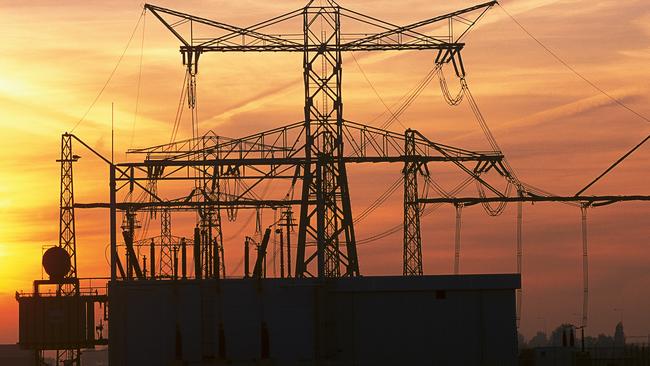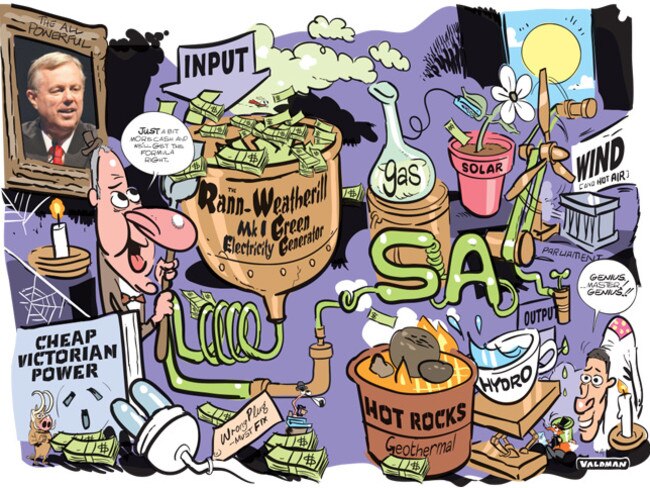Explaining why South Australia has very high electricity costs
WHEN it was revealed that some of SA ‘s key employers were close to shutting down due to surging electricity prices, it sparked a furious debate over renewable energy. With electricity prices set to rise further, we shed some light on what’s going on.

SA News
Don't miss out on the headlines from SA News. Followed categories will be added to My News.
- Mega solar project to power 100 jobs
- David Penberthy: Mike Rann’s vision risks turning off lights for SA
- Why BHP’S SA power bill hit $2.5m — in one day
WHEN The Advertiser last week revealed some of the state’s biggest employers were close to temporarily closing due to surging SA electricity prices making business too expensive, it kicked off furious debate over the pros and cons of renewable energy. SA Labor’s evangelical pursuit of green power has been blamed for forcing us to rely on other states to simply keep the lights on. With electricity prices set to rise further, we shed some light on what’s going on.
Where does South Australia’s power come from?
During the 2015 financial year, gas accounted for 37 per cent of the electricity, wind 34 per cent, coal 23 per cent, and solar 7 per cent. Additionally, SA imported around 10 per cent of its total from Victoria via the interconnector to meet demand when there was not enough capacity locally.
With the closure of Alinta’s Northern power station at Port Augusta occurring on May 9 this year, coal is now out of the equation. At 1pm yesterday, SA was generating 1730 MW of electricity — of that 71 per cent wind, 24 per cent gas, and 5 per cent solar.
How does this compare to other states?
SA sits only behind Tasmania in terms of the proportion of power generated from renewable sources. The eastern seaboard, where prices are much cheaper, is still heavily reliant on coal fired power stations.
In fact, SA has among the highest share of renewable electricity in any large grid system in the world.
After exceeding its own renewable energy target to generate 33 per cent of electricity from renewable sources by 2020, the State Government revised its target upwards, aiming to generate 50 per cent of the state’s electricity from renewable energy sources by 2025.
In 2014/15, 41 per cent of power generated was from renewable sources. The vast majority was from wind with 16 operating wind farms that supplied 34 per cent of the state’s electricity.
Why have we got so much wind power?
The rapid rise in wind generation — from near zero in 2003 to largest installed level of generation in the country — has been attributed to the state’s planning laws which have made it easy to build and operate wind farms on pastoral properties.
In 2002, SA was the first state to introduce planning guidelines for wind farms and a statewide change to development plan explicitly allows wind farms to be built on all rural zoned land.
Last year the Government has created laws to specifically allow wind and solar farm developers to apply for a licence to build and operate on Crown land that is subject to a pastoral lease. The move gave operators access to 40 per cent of the state’s land area.
The rapid building of wind farms was also made possible through the Federal Government’s Renewable Energy Target scheme which creates a financial incentive for both the establishment or expansion of renewable energy power stations, and for households to renewable sources.

The Federal Government’s renewable energy target (RET) was designed to ensure that at least 33,000 GWh — or 23.5 per cent — of Australia’s electricity comes from renewable sources by 2020.
Can SA supply enough power to sustain itself?
The short answer is no. According to forecasts from the Australian Energy Market Operator, SA has the capacity to meet its own electricity needs for every day except one in the coming week. But over the medium term, demand will outstrip supply in the early part of next year.
According to SA’s Low Carbon Economy Experts Panel report, SA has sufficient renewable resources to go 100 per cent green but to ensure stability would require sources to be more diverse than wind and rooftop solar panels. It must include baseload-type energy supply that could be produced using solar thermal, geothermal and wave power.
Why where there huge price spikes last week?
The interconnector which plugs SA into Victoria’s power supply was offline because of upgrades while greater demand during the winter chill, high gas prices, and inconsistent supply from renewable sources were all factors blamed for last week’s skyrocketing prices.
Is the State Government’s renewable energy policy and is it to blame?
Analysts have blamed the Government’s hurried pursuit of renewable energy for forcing the closure of baseload fossil fuel plants like that at Port Augusta. They say the focus on wind, an unreliable power source, as opposed planning for a more diverse range of renewables that include the more reliable geothermal has contributed to price volatility since coal-fired baseload power was switched off on May 9.
Australian Industry Group chief Innes Willox said SA’s current energy crisis has many causes, but the closure at Port Augusta has helped set the scene.
“The loss of that generation capacity raises the likelihood that shortfalls in the interconnector or renewable generation send prices soaring,” he said.
“But most of all, the closure happened so fast that the market had little time to prepare or adjust. It’s a clear marker of the danger of disorderly transitions.”
But the Government and renewable energy backers have blamed a variety of other factors for the state’s volatile energy prices including privatisation, severe weather and restricted interconnector capacity.
What are the problems with interconnections, why do they need repair and why do need to build more?
The interconnector between SA and Victoria has been offline since early July, isolating SA and increasing volatility which was exacerbated by the storm, but will be back online on Monday.
It’s undergoing a full upgrade but that won’t be completed for some months after being delayed because of inclement weather. It will provide an additional 40 per cent capacity.
Business SA said the upgrade was not a “silver bullet” but would help provide some price relief.
The recent State Budget, $500,000 was allocated towards a $1 million feasibility study — co-funded with ElectraNet — to explore options for greater energy interconnection with the eastern states. This would give SA increased access to baseload power and enable renewable energy to be sold interstate. But the cost of a new interconnector could be as high as $700 million.
What are the problems with wind generated power?
Mr MacGill said the main challenge of wind power was its high variability driven by the weather which leads SA to rely on gas and energy from Victoria.
Wind farms also stop operation when it’s too windy — speeds 90km/h and higher. Mr MacGill said there was a small level of energy consumption involved with operating wind farms compared with coal-fired power stations. But on calm days wind farms could suck up more power than they generate.
Mr MacGill said several things could be done to increase wind reliability including spreading wind generators across SA including coastal areas. Larger blades could also be installed to increase turbine capacity.
Should SA have more solar generation?
SA’s solar generation relies on household rooftop panels. The state had a huge uptake — nearly one-third of SA homes have them installed — was came about off the back initial generous feed-in tariffs. However on September 30 that comes to an end.
Large-scale solar farms are popular throughout much of the rest of the world but issues with storage meant they can also be unreliable.
There have been two solar thermal plants proposed for Port Augusta, which have storage capability and now a two-stage 120MW solar and battery project proposed for Roxby Downs.
But Mr MacGill said discussions about a solar thermal would have its challenges because the technology came at a cost.
“It has the advantage around providing solar energy even as the sun goes down,” he said.
“What we have tended to see around the world is PV solar panels have really taking off, whereas concentrating solar power has a more challenging development path, it has not grown nearly as fast.”
Are prices expected to continue to rise?
Completion of the interconnector upgrade should help smooth out recent volatility. However, SA is facing wholesale electricity prices that are roughly double that of other states for more than two years, according to figures from the Australian Energy Regulator.
Wholesale energy costs are the prices charged by power stations. They add up to about half the standard business or households bill, which also includes costs for building poles and wires.
SA currently pays $70 per megawatt hour for its wholesale power, and the AER forecasts that charge will rise to peak of $94 by mid 2018, when the price in Victoria will be just $41.
What it means for households, businesses and jobs?
Business SA senior policy adviser Andrew McKenna said industry thrives on certainty and the recent high and volatile wholesale electricity prices have undermined confidence in energy intensive sectors like manufacturing and irrigated agriculture.
“While existing businesses will try and hang on in SA, it will become increasingly difficult to attract new investment and jobs in energy intensive industry should our wholesale electricity prices remain effectively double those of adjoining states,” he said.
The Australian Industry Group has estimated the cost of power price spikes in SA over the last three weeks to be more than $150 million, and in the past fortnight some of SA’s largest employers — BHP, Arrium, Adelaide Brighton Cement — have raised serious concerns about the cost of doing business in SA.
For SA residential consumers, several companies hiked rates to record levels on July 1. The average increase this financial year is $261 for EnergyAustralia customers, $228 for AGL and $117 for Origin.
Welfare groups have cited rising power prices as the number one issue being raised with their financial counsellors.
Can the problem be solved?
Addressing the issues behind SA’s current power crisis — let alone solving them — is something that will take a significant amount of time.
Mr Koutsantonis is calling for an overhaul of the national electricity market, saying it hasn’t kept pace with changes in generation methods.
Australian Industry Group chief Innes Willox said energy storage would ultimately play a large role in making the market work.
“But in the meantime gas is going to play a crucial role in balancing markets,” he said.
“The tight gas market is going to make that much more expensive and less flexible unless we act. Bringing new gas supplies to market is urgent.”


